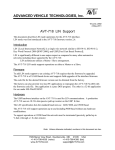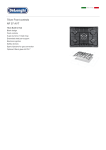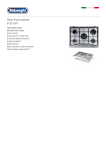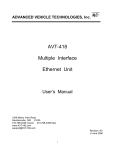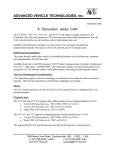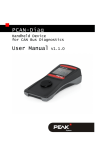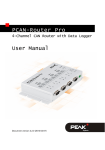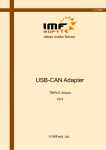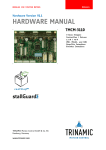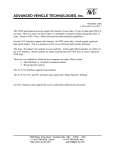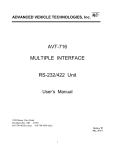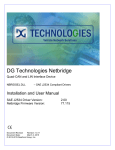Download AVT-718 Multiple Interface RS-232 or RS-422 Unit
Transcript
ADVANCED VEHICLE TECHNOLOGIES, Inc. AV inc. AVT-718 Multiple Interface RS-232 or RS-422 Unit User’s Manual 1509 Manor View Road Davidsonville, MD 21035 410-798-4038 (voice) 410-798-4308 (fax) www.AVT-HQ.com [email protected] Revision ‘C1’ 19 October 2004 1 TABLE OF CONTENTS 1. INTRODUCTION .........................................................................................................................................................4 1.1 SPECIFICATIONS..............................................................................................................................................................5 1.2 DEFINITIONS ...................................................................................................................................................................5 2. CONNECTING & USING............................................................................................................................................6 2.1 SETTING THE BAUD RATE...............................................................................................................................................6 2.2 CONNECTIONS ................................................................................................................................................................7 2.3 RS-232 OR RS-422 ........................................................................................................................................................7 2.4 COMMUNICATIONS WITH THE HOST COMPUTER .............................................................................................................7 3. INTERFACE HARDWARE.........................................................................................................................................8 3.1 INTRODUCTION ...............................................................................................................................................................8 3.2 OVERVIEW .....................................................................................................................................................................8 3.3 MICROCONTROLLER .......................................................................................................................................................8 3.4 FLASH ..........................................................................................................................................................................9 3.5 RAM..............................................................................................................................................................................9 3.6 FIFO’S ...........................................................................................................................................................................9 3.7 SCC ...............................................................................................................................................................................9 3.8 CAN...............................................................................................................................................................................9 3.9 J1850 VPW .................................................................................................................................................................10 3.10 J1850 PWM...............................................................................................................................................................10 3.11 KWP 2000 .................................................................................................................................................................10 3.12 UBP ...........................................................................................................................................................................10 3.13 LIN ............................................................................................................................................................................10 3.14 MICROSECOND CLOCK ...............................................................................................................................................12 4. AVT-718 OPERATION ..............................................................................................................................................12 4.1 INDICATORS..................................................................................................................................................................12 4.2 RS-232.........................................................................................................................................................................12 4.3 RS-422.........................................................................................................................................................................13 4.4 VEHICLE NETWORKS ....................................................................................................................................................13 5. COMMUNICATIONS ................................................................................................................................................13 5.1.1 Packet Construction .............................................................................................................................................13 5.1.2 Transmit message format .....................................................................................................................................14 5.1.2.1 Transmit Acknowledgment ............................................................................................................................................. 14 5.1.3 Transmit Message Status Byte Definitions ...........................................................................................................15 5.1.3.1 Transmit message example.............................................................................................................................................. 15 5.1.4 Receive message format .......................................................................................................................................15 5.1.4.1 Received message time stamping .................................................................................................................................... 15 5.1.4.2 Received message example ............................................................................................................................................. 16 5.1.5 Received Message Status Byte Definitions...........................................................................................................16 5.1.6 More Examples ....................................................................................................................................................16 5.1.7 Alternate Header Formats ...................................................................................................................................17 5.2 VPW MODE .................................................................................................................................................................18 5.3 PWM MODE ................................................................................................................................................................18 5.3.1 PWM Active Node ................................................................................................................................................18 5.3.2 PWM Passive Network Monitor ...........................................................................................................................18 5.3.3 PWM “Look Alike” ..............................................................................................................................................19 5.4 KWP MODE .................................................................................................................................................................19 5.5 CAN MODE..................................................................................................................................................................20 5.6 UBP MODE ..................................................................................................................................................................20 5.7 MATCH FUNCTION - MESSAGE FILTERING ....................................................................................................................20 2 5.8 STATUS AND ERROR CODES .........................................................................................................................................21 6. TECHNICAL INFORMATION ................................................................................................................................21 6.1 REFERENCE DOCUMENTATION .....................................................................................................................................21 6.2 TECHNICAL SUPPORT ...................................................................................................................................................22 6.3 AVT-718 HARDWARE INFORMATION...........................................................................................................................22 6.3.1 Fuse F1 ................................................................................................................................................................22 6.3.2 Jumper Block JP1 ................................................................................................................................................23 6.3.2.1 AVT-718 PC board revision levels “A” to “F” ............................................................................................................... 23 6.3.2.2 AVT-718 PC board revision level “G”............................................................................................................................ 23 6.3.2.3 AVT-718 PC board revision level “AA”......................................................................................................................... 24 6.3.3 Jumper JP2 ..........................................................................................................................................................28 6.3.4 Connector P1 .......................................................................................................................................................28 6.3.5 Connector P2 .......................................................................................................................................................28 6.3.6 Connector P3 .......................................................................................................................................................29 6.3.7 Connector P4 .......................................................................................................................................................31 6.4 AVT-718 ENCLOSURE .................................................................................................................................................33 7. COMPANY OVERVIEW...........................................................................................................................................33 FIGURE 1 FIGURE 2 FIGURE 3 FIGURE 4 AVT-718 BLOCK DIAGRAM ..............................................................................................................................11 DIAGRAM OF JP1 (BOARD REVISIONS “A” TO “F”)............................................................................................25 DIAGRAM OF JP1 (BOARD REVISION “G”) .........................................................................................................26 DIAGRAM OF JP2 ...............................................................................................................................................28 TABLE 1 TABLE 2 TABLE 3 TABLE 4 TABLE 5 TABLE 6 TABLE 7 TABLE 8 DEFAULT CONFIGURATION OF JP1 (BOARD REVISIONS “A” TO “F”) ..................................................................25 DEFAULT CONFIGURATION OF JP1 (BOARD REVISION “G”)................................................................................26 DEFAULT CONFIGURATION OF JP1 (BOARD REVISION “AA”) .............................................................................27 RS-232 BAUD RATE SELECTION .........................................................................................................................28 CONNECTOR P3 (REVISIONS “A” TO “G”) ..........................................................................................................30 CONNECTOR P3 (REVISIONS “AA” AND LATER).................................................................................................31 P4 PIN DESCRIPTIONS, RS-232 ..........................................................................................................................32 P4 PIN DESCRIPTIONS, RS-422 ..........................................................................................................................32 3 1. INTRODUCTION This manual covers the AVT-718 Multiple Protocol Interface unit. It provides technical information on using the interface, connections to it, communications with it, and other related information. The AVT-718 Multiple Protocol Interface supports the following network protocols. • CAN (Controller Area Network). CAN-B (ISO 11519). CAN-C (ISO 11898). Single Wire CAN (SWC) (SAE J2411) support. • J1850 VPW GM Class 2 compliant. • J1850 PWM Ford SCP compliant. • Keyword Protocol 2000 support ISO 14230 and ISO 9141. • Ford UBP (UART Based Protocol). • LIN support. The AVT-718 Hardware package (order number: 718-002) consists of the AVT-718 Multiple Interface board housed in rugged enclosure and a 9-pin serial cable. All documentation is available from our web site at: www.AVT-HQ.com/download.htm. The AVT-718 OEM module (order number: 718-003) consists of the AVT-718 Multiple Interface board with a set of mounting brackets attached. All documentation is available from our web site at: www.AVT-HQ.com/download.htm. Operations in CAN mode are compatible with ISO 11898, J1939, ISO 11512, ISO 15765 and other related specifications. Operations in J1850 VPW mode conform to specification J1850 and GM Class 2 requirements. Operations in J1850 PWM mode conform to specification J1850 and Ford SCP (Standard Corporate Protocol) requirements. Operations in UBP mode conform to Ford Motor Company UBP requirements. Operations in LIN mode conforms to LIN specification 1.2. Refer to updated documentation, manual supplements, and other engineering notes found on our web site for up-to-date hardware and firmware information about this product. Contact us for specific information on current status of this unit. 4 The AVT-718 Multiple Interface provides the following functions: • Isolated electrical interface between the network and the control computer. • Protocol/data conversion between a vehicle based network and the host computer (via a serial communications link). • Active network node. • Passive network traffic monitor. 1.1 Specifications AVT-718 Multiple Interface (in enclosure) • • • • • • Overall size (inches): 7.3 x 6.1 x 2.0. Weight: 18 oz. Operating temperature range: 0 to +70 degrees C. +12 volts (nominal) from subject vehicle. Input voltage range: +9.0 VDC to +30.0 VDC. Power dissipation: 3.0 watts (nominal). AVT-718 Multiple Interface (OEM board) • Overall size (inches): 7.6 x 5.7 x 0.7. • Weight: 8 oz. • Operating temperature range: 0 to +70 degrees C. • +12 volts (nominal) from subject vehicle. • Input voltage range: +9.0 VDC to +30.0 VDC. • Power dissipation: 3.0 watts (nominal). MTBF (Mean Time Between Failure) • MTBF information has not been discovered for many components used on the AVT-718 Multiple Interface board. The known values follow: ♦ Relays (all except K4 and K5): 500 million operations. ♦ Relays (K4 and K5 only): 200 million operations. ♦ Toggle switch, S1: 40,000 cycles. ♦ DC/DC converter, U32: 4.4 million hours. ♦ DC/DC converter, U39: 1.0 million hours. 1.2 Definitions The following terms are used in this manual. • CAN: Controller Area Network. • CAN-C: Physical layer name for ISO 11898 compliant hardware interface. • CAN-B: Physical layer name for ISO 11512 compliant hardware interface. 5 • • • • • • • • • • CRC: Cyclic Redundancy Check. DLC: Data Link Controller. [Motorola term, VPW] HBCC: Hosted Bus Controller Chip. [Ford device, PWM] KWP: Keyword Protocol 2000 (ISO 14230). SCC: Serial Communications Controller. [A dual UART device] SCI: Serial Communications Interface. [Motorola term] SCP: Standard Corporate Protocol. [Ford Motor Company] SWC: Single Wire CAN. [J2411] UBP: UART Based Protocol. [Ford Motor Company unique] All numbers used in this manual are hexadecimal digits (0 .. 9 and A .. F) and are usually preceded with a dollar sign ($) for clarity. 2. Connecting & Using Prior to using the AVT-718 the baud rate of the serial link between it and the host computer must be properly set. The interface must then be connected to both the subject vehicle and the host computer. 2.1 Setting the Baud Rate The AVT-718 serial interface (to the host computer) can be configured for one of four baud rates: • 19.2 kbaud • 38.4 kbaud • 57.6 kbaud • 115.2 kbaud The factory default setting for the AVT-718 is 19.2 kbaud. Regardless of baud rate, all communications between the host computer and the AVT-718 unit is standard UART serial, in binary format (not ASCII hex), 10 bit frame, 1 start bit, 8 data bits, no parity, one stop bit. Hardware handshaking in the form of RTS / CTS signaling is used between the AVT-718 and the host computer. This method of flow control prevents loss and/or corruption of data in communications between the AVT-718 and the host computer. All communications between the AVT-718 and the host computer is in binary bytes (not ASCII hex digits). The baud rate is determined by setting two shunts on JP2 on the AVT-718 board. Refer to Section 6.3.3 for details on setting the shunts and a diagram of JP2. 6 2.2 Connections Initial use and testing require that the AVT-718 be connected to a power supply and the host computer serial port. Refer to Sections 6.3.2, 6.3.6, and 6.3.7 for pin assignments of the AVT-718 connectors. The external power source should be a nominal +12v (minimum of +9.0v and maximum of +30.0v). It is recommended that the serial cable (provided with the “hardware” package, #718-002) be used during initial testing. Serial communications between the AVT-718 and the host computer utilize RTS/CTS hardware handshaking - all relevant pins must be connected. No other equipment or connections are required to get the unit up and running and establish communications between the AVT-718 and the host computer. 2.3 RS-232 or RS-422 Communications with the host computer are via a serial communications link. The AVT-718 is configured at the factory for either RS-232 or RS-422 for the communications link to the host computer. It is not recommended that the user attempt to change the configuration “in the field.” To identify which configuration an AVT-718 is set for, look on the AVT-718 PC board, near the DE-9S connector. Locate devices U37 and U40. • If U37 is installed then the unit is set for RS-232 operations. • If U40 is installed then the unit is set for RS-422 operations. At no time should both devices be installed. There are other minor differences between the two configurations; some resistors are either installed or not installed. Contact the factory if you require additional information about the configuration of an AVT-718. 2.4 Communications with the Host Computer Once the hardware connections have been made, proper operation of the hardware can be observed. • On the host computer use a binary communications program. [Contact the factory for a free copy of our “Hex Terminal” software. Hex terminal software is available for DOS, Win3.1x, and Win98/NT.] • Set the parameters of the communications program appropriately (as determined by the configuration of the AVT-718 interface). • Turn on the AVT-718 interface unit. • Observe on the AVT-718 board that the green (power) LED is lit. • Observe that the red (operations) LED is blinking fast. 7 • Observe on the computer that the following is received from the interface: 91 12 and 92 04 xx. This is the ‘mode of operation’ report. $91 indicates that the message is a ‘board status report’ with one byte to follow. The $12 indicates the interface is up and running at idle awaiting a mode switch command. The $92 $04 $xx is the firmware version report, where ‘xx’ is the firmware version. Refer to the “Master Commands and Responses” document for complete and up-to-date information. Note: The AVT Controller software only displays and accepts hex digits, no dollar signs. • At this point the AVT-718 hardware is operational. 3. Interface Hardware The following sections provide a brief description of the hardware implementation of the AVT-718. A block diagram of the AVT-718 Multiple Interface is shown in Figure 1. Included on the block diagram are all signal assignments and pin numbers for JP1 and P3. 3.1 Introduction The AVT-718 provides an isolated electrical interface between the control computer and the connected vehicle network. The AVT-718 Interface can be connected directly to a vehicle and derives its operating power from the vehicle. The serial interface to the host computer is electrically isolated from the vehicle electrical and electronic systems. This is done to prevent damage to the host computer due to spikes or surges from the vehicle electrical system. It is not recommended that the control computer be connected directly to the vehicle electrical system. The AVT-718 Multiple Interface performs the necessary data and protocol conversion functions as well as many other functions that can be enabled or disabled by the user to meet specific application needs. 3.2 Overview The hardware is structured around a central microcontroller, including on-chip peripherals. The microcontroller utilizes several off-chip peripheral devices: FLASH memory; RAM; FIFO’s; serial communications controller (SCC); CAN controller; J1850 VPW DLC device; J1850 PWM HBCC device; and a free running 24-bit microsecond clock. Also included in the hardware are transceivers for the various network interfaces. These may be unique devices or implementations using discrete components. 3.3 Microcontroller The heart of the AVT-718 Multiple Interface is the Motorola 68332 microcontroller which contains a CPU32 core. The microcontroller contains 2 Kbytes of on-board RAM as well as a number of peripheral functions (chip select, SCI, SPI, TPU, etc.). 8 The microcontroller currently runs at a bus speed of 16.777 MHz (which may be increased at a later time). Firmware revision 3.0 and later increased the microcontroller speed to 20.972 MHz 3.4 FLASH All operational firmware is contained in a 128 Kbyte FLASH (64 K x 16) device that is socket mounted on the AVT-718 board. All firmware on the AVT-718 Multiple Interface was developed by and is supported by Advanced Vehicle Technologies, Inc. The AVT-718 supports the ability to upgrade operational firmware in the field, without requiring the removal/replacement of the FLASH device. Firmware routines exists in the FLASH device to permit updating the AVT-718 operational firmware from the host computer via the serial data link; without requiring the removal/replacement of the FLASH device. Contact the factory if you want to update the firmware on your AVT-718 unit. We can supply, by e-mail, the firmware file and a program to update the AVT-718 FLASH device. We can provide a DOS and/or a Win95/98/NT/2000/XP program for the host computer to update the AVT-718 FLASH device. 3.5 RAM 8 Kbytes (8 K x 8) of RAM are provided by an external RAM device. 3.6 FIFO’s Two high speed hardware FIFO’s are used by the microcontroller as buffers for transmit and receive data moving between itself and the host computer. Each FIFO is 2 KBytes deep. One is used for incoming data (from the host) and the other is used for outbound data (to the host). 3.7 SCC Serial communications with the host computer is provided by one half of the Philips Serial Communications Controller (SCC) device. The SCC is used to implement the standard serial data link, including RTS/CTS hardware handshaking. The host computer serial data link is electrically isolated from the rest of the AVT-718 Multiple Interface unit. The RS-232 line drivers and receivers are contained in an electrically isolated section of the AVT-718 board. Signals are coupled through optical isolators and power is supplied by an isolated DC-DC converter. 3.8 CAN CAN operations are supported by the Intel 82527 CAN Controller device. 9 Board revision “G” and later offer three physical layer transceivers; selected by software control: • CAN-C; ISO 11898; J1939; 2-wire CAN. The Philips 82C250 transceiver is used. On later versions, this transceiver was replaced with the Philips TJA1050T. • CAN-B; ISO 11519; 2-wire CAN. The Philips TJA1054 transceiver is used. • SWC; Single Wire CAN; J2411. The Philips AU5790 transceiver is used. 3.9 J1850 VPW J1850 VPW operations are supported by the Motorola DLC device (MC68HC56/57/58). Additionally, the AVT-718 supports full GM Class 2 operations (block transfer mode, 4X mode, etc.). 3.10 J1850 PWM J1850 PWM operations are supported through the use of the Motorola HBCC (Hosted Bus Controller Chip) device. Using this device ensures Ford Motor Company SCP operational compliance. The physical layer transceiver is implemented in discrete components in accordance with Ford Motor Company design specifications. 3.11 KWP 2000 Key Word Protocol (KWP) 2000; ISO 14230; is implemented using the second half of the serial communications controller (SCC). The K-line transceiver and the L-line transmitter are implemented using an Advanced Vehicle Technologies, Inc. proprietary design. 3.12 UBP Ford’s UART Based Protocol (UBP) is implemented using the microcontroller internal SCI peripheral. The Motorola UART Based Protocol Physical Layer (UPL) transceiver (SC74935DH) is used. Pull-up resistor R51 is factory set for 18.2 Kohms. This resistor may be changed, as required by the user. The UBP firmware was designed to conform to Ford published UBP specifications. 3.13 LIN Local Interconnect Network (LIN) is implemented using the microcontroller internal SCI peripheral. The UBP transceiver (described above) is used. True compliance with the LIN specification requires that either an external pull-up resistor be used, or pull-up resistor R51 be changed to meet user requirements. The AVT-718, in LIN mode of operations supports both Master and Slave communications on a message by message basis. Additionally, when not commanded to perform as either a Master or a Slave, the AVT-718 passively monitors the network, receives all network traffic, and forwards it all to the host. 10 JP1 RAM CAN Controller FLASH Data Routing Logic Heart Beat LED (red) 11 CAN_H 12 6 Relay 13 CAN_L 14 14 Relay 15 S W C 16 9 Relay 17 UBP 18 3 Relay 1 VPW Bus 2 2 Relay 3 PWM Bus+ 4 Relay 5 PWM Bus- 6 10 K - line Transceiver Relay 7 K-line 8 7 L - line Transmitter Relay 9 L-line 10 15 20 8 22 12 SWC Transceiver I/O Ports DLC (VPW Interface) MC68332 Microcontroller HBCC (PWM Interface) P3 Relay 2-wire Transceiver UPL (UBP transceiver) Control and monitor signals JP1 PWM Transceiver FIFO #1 FIFO #2 To Host Computer RS-232 Transceiver Signal Isolation Dual Serial Communications Controller logic Power Regulation & Distribution Isolated DC - DC Converter Power LED (green) Figure 1 AVT-718 Block Diagram 11 Transient Protection 19 1 21 11 Batt + 13 Sig. Gnd. 5 Chassis Gnd. 4 3.14 Microsecond Clock The AVT-718 utilizes a free running 24-bit microsecond clock for all time related functions. This includes message time stamps and byte and message time intervals in KWP, UBP, and LIN modes; all of which are heavily time dependent for proper operations. The clock tick interval is 1.0 microsecond. The clock rolls over at $00 FF FF FF. The rollover interval is 16.777 216 seconds. 4. AVT-718 Operation The following describes the use of the AVT-718 Multiple Interface. It is assumed that: • The interface is properly connected to an external vehicle network and to the control computer. • Appropriate communications application software is installed and running on the host computer. • Communications between the host computer and AVT-718 have been successfully tested, as described in Section 2.3. 4.1 Indicators The AVT-718 board has two indicator LED’s: one green and one red. The green LED is connected to the +5 VDC supply for the board and provides a quick indication that power is available for normal operation. If the green LED should fail to light, check the power source from the subject vehicle, and check fuse F3 on the AVT-718 board. The red LED is a heartbeat indicator. The microcontroller toggles the state of the red LED every 62.5 milliseconds during normal operations. During FLASH programming mode, the red LED will flash on one second intervals. If a problem with the microcontroller should occur the red LED will, most likely, go to a full ON or full OFF state. This should be readily apparent and be indicative of an abnormal condition. 4.2 RS-232 When configured for RS-232, all communications between the AVT-718 Multiple Interface and the host computer conform, at the physical interface, to EIA-RS-232 standard. Communications between the interface unit and the host computer follow industry standard serial communications protocol. There is one start bit, eight data bits (least significant bit first), no parity, and one stop bit. Additionally, hardware handshaking using the RTS/CTS signal lines is implemented. The AVT-718 uses RS-232 for communications with the host computer. As such, the output data line, TXD, idles low (-8 volts) and the RTS signal line idles high (+8 volts). Likewise, the 12 AVT-718 expects RXD to idle low and CTS to idle high. (All voltages measured with respect to the communications isolated ground.) The user should be aware of potential communications errors that may occur when using RS-232 at the higher data rates or in an electrically noisy environment. 4.3 RS-422 When configured for RS-422, all communications between the AVT-718 Multiple Interface and the host computer conform, at the physical interface, to EIA-RS-422 standard. Communications between the interface unit and the host computer follow industry standard serial communications protocol. There is one start bit, eight data bits (least significant bit first), no parity, and one stop bit. Additionally, hardware handshaking using the RTS/CTS signal lines is implemented. 4.4 Vehicle Networks All communications between the AVT-718 Interface and the external vehicle network were designed to be in conformance with all relevant standards and specifications. 5. Communications The structure and protocol of communications between the AVT-718 Multiple Interface and the host computer are stated in the following sections. 5.1.1 Packet Construction All communications between the AVT-718 and the host computer are accomplished in “packets.” Packets from the host computer to the AVT-718 are known as Commands. Packets from the AVT-718 to the host computer are known as Responses. All data is transferred in packets. The size of each data packet varies depending on the mode of operation. For most modes the packet length is from 1 to 16 bytes (inclusive) but may be as much as 260 bytes in KWP mode and much larger in VPW block transfer mode. The first byte in each data packet is called the HEADER BYTE and is used to convey information only between the control computer and the AVT-718 Multiple Interface. The header byte is divided into the upper nibble and lower nibble. The upper nibble indicates what information the data packet is conveying. The lower nibble is the count of the number of bytes that follow the header byte. The meaning of the upper nibble of the header byte depends on which direction the data packet is moving; whether to or from the control computer. There are occasions where packets between the AVT-718 and the host computer are more than 15 bytes in length. To support these longer packets, two alternate forms have been developed. 13 Refer to Section 5.1.7 of this manual and/or refer to the document “Long Messages - Alternate Header Formats.” 5.1.2 Transmit message format To transmit a message onto the network, the message must be built by the operator and then sent to the AVT-718. The CRC or checksum byte will be automatically calculated and appended onto the message when transmitted. In some operational modes this function can be enabled or disabled by software command. Any message destined for transmission must be preceded by a byte whose upper nibble is ‘0’ (zero) and lower nibble is the byte count of the message (unless one of the alternate header forms is used). The message bytes then follow immediately. It is up to the user to determine and know the proper messaging strategy that is used on the external network to which the AVT-718 is attached. 5.1.2.1 Transmit Acknowledgment Each time a message transmission is attempted the interface will issue some kind of transmission acknowledgment. The type and meaning of this transmission acknowledgment is dependent on the mode of operation. For VPW and KWP modes, the transmit status byte definition is the same as the receive message status byte. CAN mode does not have a transmit status byte. PWM does not have a transmit status byte, but the AVT-718 will forward any received acknowledgments to the host computer. In UBP mode of operation, when a message is transmitted onto the network, the AVT-718 will issue a receive message report to the host, along with a status byte. The AVT-718 will also issue a separate transmit status report. Some operational modes permit the user to enable or disable the function “Forward messages from this device.” When enabled, the host receives a complete copy of the message just transmitted, with the status bits set accordingly. When disabled, the host receives just the status byte (for example, 01 60). Refer to the “Master Command and Responses” document for detailed information on each specific mode of operation. 14 5.1.3 Transmit Message Status Byte Definitions Refer to the “Master Commands and Responses” document for exact bit definitions of the status byte that accompanies the transmit acknowledgment. 5.1.3.1 Transmit message example The user has set the AVT-718 to VPW mode. The user wants to send the following OBD-II query: 68 6A F1 01 00. The user assembles and sends the following packet to the AVT-718: 05 68 6A F1 01 00. After the AVT-718 has transmitted the message onto the network, successfully, the user receives the following at the host computer: 01 60 5.1.4 Receive message format Messages received from the network are assembled into the original byte sequence. The received CRC or checksum is calculated and checked to be equal to the CRC or checksum byte at the end of the received message. The received status byte is updated and the entire packet is sent to the host. Depending on the mode of operation, the received CRC/checksum byte is discarded or preserved according to command $52 $01 $xx. (In VPW and CAN mode the CRC/checksum byte is always discarded.) Some modes of operation enforce format checking rules to the received message (even if it was transmitted by the AVT-718). The user should consult the appropriate specifications and related documents for details on the format of messages in specific modes of operation. Status of all such tests are indicated in the received status byte. 5.1.4.1 Received message time stamping All modes of operation support received message time stamping. This function is enabled or disabled by the user through the use of the 5x 08 command. If time stamps are disabled (default setting), then the format of a received message is: ◊ Header byte(s); 1 to 3 bytes. (Depending on the packet size, one of the alternate header formats may be used.) ◊ Received status byte; 1 byte. ◊ Message bytes ... If time stamps are enabled, then the format of a received message is: ◊ Header byte(s); 1 to 3 bytes. (Depending on the packet size, one of the alternate header formats may be used.) ◊ Time stamp; 4 bytes. 15 ◊ ◊ Received status byte; 1 byte. Message bytes ... 5.1.4.2 Received message example As an example the byte sequence $A7 $B6 $C5 plus CRC or checksum byte appears on the network. The message is received by the AVT-718 and the following byte sequence is passed to the host computer: $04 $00 $A7 $B6 $C5 (time stamping is disabled). The byte $04 indicates that it is a received message and that four bytes follow. The byte $00 is the received message status byte and indicates that no errors were found. (Received message status byte, bit definitions are listed in the next section.) The message bytes then follow. Note that the CRC or checksum byte is stripped off. 5.1.5 Received Message Status Byte Definitions The user should consult the “Master Commands and Responses” guide for the most up-to-date listing of the bit definitions for the received message status byte for each mode of operation. 5.1.6 More Examples To illustrate the construction and decoding of packets between the control computer and the AVT-718 Multiple Interface, several examples are provided. Example #1: Want to request the current operational mode. Command: D0. The AVT-718 responds with: 91 14. The ‘9’ indicates a board status response. The ‘1’ indicates one byte follows The ‘14’ indicates UBP mode. Example #2: want to send a message out on the bus. Command: 04 32 89 AC 5F. The AVT-718 responds with: 01 40. The ‘0’ indicates a received message from the network. The ‘1’ indicates only one byte follows. The one byte is the received message status byte. The ‘40’ is the received message status byte with bit 6 only being set. Bit 6 is set. This means the received message was ‘from this device’ meaning the AVT-718 unit. Messages transmitted by the AVT-718 are received by the AVT-718. They are checked for errors. Unless otherwise configured, only the status byte is sent to the host In UBP mode, the AVT-718 will also send the transmission acknowledgment A1 20 which indicates that the message was successfully transmitted. 16 5.1.7 Alternate Header Formats There are occasions where packets between the AVT-718 and the host computer are more than 15 bytes in length. To support these longer packets, two alternate forms have been developed. The user may also refer to the document “Long Messages - Alternate Header Formats.” To accommodate long messages, the format for communications between the AVT-718 unit and the host computer has been modified. The host has three methods available for passing a packet to the AVT-718 for transmission onto the vehicle network. All three methods are described here, along with examples. If the message is 15 bytes or less in length (total) then the 'normal' format may be used. Normal Format: 0x aa bb cc ... x - count of bytes to follow aa bb cc ... message bytes. Example: 05 81 F1 C1 48 9B If the message is more than 15 bytes but less than 255 bytes in length, alternate format #1 is available using a header byte of $11. Alternate format #1: 11 xx aa bb cc ... 11 - header byte xx - count of bytes to follow aa bb cc ... message bytes. If the message is more than 255 bytes in length, alternate format #2 is available using a header byte of $12. Alternate format #2: 12 xx yy aa bb cc ... 12 - header byte xx - count of bytes to follow, most significant byte yy - count of bytes to follow, least significant byte aa bb cc ... message bytes. These formats are backward compatible and may be used as desired. For example, the host wants to transmit the following message onto the bus: A1 B2 C3 D4 E5 F6 A7 B8 C9 DA EB FC AD BE The following messages from the host to the AVT-718 are all equivalent. The header byte(s) are bold and underlined for clarity. 0E A1 B2 C3 D4 E5 F6 A7 B8 C9 DA EB FC AD BE 11 0E A1 B2 C3 D4 E5 F6 A7 B8 C9 DA EB FC AD BE 12 00 0E A1 B2 C3 D4 E5 F6 A7 B8 C9 DA EB FC AD BE 17 5.2 VPW Mode Consult the latest version of the “Master Commands and Responses” document for detailed information on the commands supported by the AVT-718 while in VPW mode of operation. The latest version of the “Master Commands and Responses” document can be obtained from our web site at: http://www.avt-hq.com When in VPW mode of operation the interface is always listening to, or monitoring, the external network. All bus traffic is reported to the control computer by the interface. Transmit operations occur only when initiated by the control computer. 5.3 PWM Mode Consult the latest version of the “Master Commands and Responses” document for detailed information on the commands supported by the AVT-718 while in PWM mode of operation. The latest version of the “Master Commands and Responses” document can be obtained from our web site at: http://www.avt-hq.com Operations in PWM mode are quite different than in VPW or UBP modes. There are essentially two modes of operation while PWM mode. 5.3.1 PWM Active Node One mode is where the AVT-718 is an active node. As such it is capable of receiving and transmitting network messages. Note that only messages destined for the AVT-718 will be received from the network, acknowledged to the network, and forwarded to the host computer. Upon entering PWM mode or resetting the HBCC device the HBCC is set up with node address of $F1 (for node-to-node messages) and the functional message table is set for OBD-II messages: $4A, $4B, $5A, $5B. These settings can be altered by the user. Consult the two documents: “HBCC Initialization Parameters” and “HBCC Interrupt Register Definitions” for more details on how to change the configuration of the HBCC. 5.3.2 PWM Passive Network Monitor A second mode of operation is “network monitor” mode. In this mode the AVT-718 becomes a passive network node and cannot transmit any network messages. The AVT-718 will see all network messages, including acknowledgments, and forward all information to the host computer. When in PWM mode: ◊ Enter “network monitor” mode by sending the command: 83 01 02 16 ◊ Exit “network monitor” mode by sending the command: 83 01 02 72 18 5.3.3 PWM “Look Alike” There exists a “Look Alike” mode for PWM operations. This mode was developed to allow the AVT-718 to ‘mimic’ VPW operations while in PWM mode. More specifically, an OBD-II query in VPW mode is of the form: 68 6A F1 xx yy But in PWM mode the same query is of the form: 48 6A xx yy. Note that the priority/type byte is different and the source address byte is missing. The response from the AVT-718 in normal PWM mode includes the CRC byte at the end. If the AVT-718 is put into PWM mode and “Look Alike” is enabled the user can treat the AVT718 as if it were in VPW mode (for OBD-II queries). The AVT-718 will change the “68” byte from the host to “48”, the source address byte is stripped out and used to update the HBCC node address, and the CRC byte is stripped from the response message. Note that the received CRC byte is stripped from the received message when either the CRC byte forwarding is disabled (5x 01 command) or when “Look Alike” mode is enabled (5x 14 command). The user should be aware of the interaction between these two commands. 5.4 KWP Mode Consult the latest version of the “Master Commands and Responses” document for detailed information on the commands supported by the AVT-718 while in KWP mode of operation. The latest version of the “Master Commands and Responses” document can be obtained from our web site at: http://www.avt-hq.com Note: Since the AVT-718 supports operations in Keyword Protocol 2000 mode, it will support ISO 9141 and ISO 9141-2 operations. Operations in KWP mode are slightly different than in VPW mode. When first entering KWP mode, the AVT-718 is disconnected from the network (K-line). There are two ways to connect to the network. 1. Conduct a communications initialization with the vehicle. The AVT-718 supports all three methods, as required by the ISO 14230 specification. The three initialization methods are mentioned here. Consult the document “Keyword Protocol 2000 Initialization” for detailed information about each of these initialization sequences. A. CARB mode initialization. This is the mode that should be used for ISO 9141-2 applications; such as OBD-II operations. The command is: $61 11. B. 5-Baud mode initialization. The command is: $61 12. C. Fast initialization. The command is: $6x 13 yy zz ... Note that following successful initialization of the communications link, the AVT-718 will monitor for transmitted messages. If no transmit activity is sensed within 4.5 19 seconds the AVT-718 will automatically transmit a Mode 1 PID 0 request (this is an OBD-II query). This is known as the “Keep Alive” message and is used to keep the communications link open or active. The “Keep Alive” message can be changed or disabled by the user. 2. Issue the $61 04 command. This will shut the K-line relay and connect the AVT-718 unit to the network K-line. Unless changed by the operator (using the 53 03 xx yy command) the AVT-718 defaults to the K-line baud rate of 10.4 kbps. Any network traffic will be received by the AVT-718 unit and forwarded to the host computer. 5.5 CAN Mode Consult the latest version of the “Master Commands and Responses” document for detailed information on the commands supported by the AVT-718 while in CAN mode of operation. The latest version of the “Master Commands and Responses” document can be obtained from our web site at: http://www.avt-hq.com Operations in CAN mode are quite different than any other mode. The user is also referred to the document “A Discussion about CAN” for detailed information on CAN operations and the construction of packets between the AVT-718 and the host computer. 5.6 UBP Mode Consult the latest version of the “Master Commands and Responses” document for detailed information on the commands supported by the AVT-718 while in UBP mode of operation. The latest version of the “Master Commands and Responses” document can be obtained from our web site at: http://www.avt-hq.com Operations in UBP mode are very similar to operations in VPW mode. Upon entering UBP mode, the AVT-718 will monitor for transmitted messages. If no transmit activity is sensed within 4.5 seconds the AVT-718 will automatically transmit a “Keep Alive” message. The “Keep Alive” message can be changed or disabled by the user. 5.7 Match Function - Message Filtering A coarse filtering mechanism for messages received from the bus is provided by the AVT-718 Interface unit firmware. The match function is not applicable to CAN mode of operation. If the match table is cleared (on power-up, reset, or $31 $7B command) all messages received from the network are passed to the host. Refer to the “Master Commands and Responses” document for updated information about the Match Function. New capabilities include: • ‘Pass to host’ on match and ‘discard’ on match functions. • Capability for 2-byte logical “AND” matching. 20 When at least one entry is made to the match table, all messages received from the network are checked against the match table. If a match is found the message is passed to the host. If no match is found, the message is discarded, and the host is not notified. A match table entry is made using the $32 $xx $yy command. The $xx value is the byte position and the $yy value is the byte value. This filtering mechanism is more easily explained by example. It is desired to receive all messages (at the host) where the third byte of the message is equal to $F1. Send the command $32 $03 $F1 to the AVT-718 interface. To verify the table entry send the command $30. The response will be $42 $03 $F1. The only network messages passed to the host will now be of the form: $zz $xx $F1 $... Note that at the host the message will be $rr $ss $zz $xx $F1 $.. where $rr is the header byte, $ss is the received message status byte, and the message follows. The match table can hold ten entries where an entry consists of a byte position and a byte value. The byte position refers to where in the network message the match byte is to be compared. The first byte of the message has a byte position value of one. Ordering of the match table is not important. All table entries are checked until a match is found or the end of the table is encountered. If a match table entry specifies a byte position that doesn’t exist for the message being checked (the message is shorter than the table entry), that table entry is not checked. Note that the header byte and the received message status byte are not included in the match function nor are these two bytes considered part of the message. When in UBP and ISO modes the byte following the header byte is the received message status byte. When in PWM mode the byte following the header byte is the message number. These bytes are ignored by the match function and are not counted. The very next byte is the first byte of the message and has is byte number one of the message. 5.8 Status and Error Codes Consult the latest version of the “Commands and Responses” list for a complete list of Status and Error codes supported by the AVT-718. The latest version of the “Commands and Responses” document can be obtained from our web site at: www.AVT-HQ.com 6. Technical Information 6.1 Reference Documentation Listed here are Specifications and other documentation related to the AVT-718 and the functions which it performs. 21 1. SAE J1850. (www.sae.org) 2. SAE J1979. 3. SAE J2411. 4. SAE J1939. 5. ISO 9141. 6. ISO 9141-2. 7. ISO 14230. 8. ISO 11898. 9. ISO 15765. 10. ISO 11519. 11. LIN. (www.lin-subbus.org) 6.2 Technical Support The user may contact Advanced Vehicle Technologies, Inc. for assistance in any of the areas covered here. When requesting assistance please identify yourself, your company, the model number of the unit, and the serial number. Use of e-mail is preferred. You may also call or send a fax. Advanced Vehicle Technologies, Inc. is located in Maryland and is open from 0800 hrs. to 1800 hrs. Eastern Time. If calling after hours, please leave a message and we will return your call as quickly as possible. We can be contacted: E-mail at: Voice: Fax: [email protected] +1-410-798-4038 +1-410-798-4308 6.3 AVT-718 Hardware Information The following sections contain information about the AVT-718 Multiple Interface board. Information about the enclosure is contained in Section 6.4. 6.3.1 Fuse F1 Fuse F1 on the AVT-718 board is a 500 milliamp fast blow fuse designed to protect the AVT718 in the event of reverse voltage application or a voltage surge significant enough to trip the input transient voltage suppressor. 22 The fuse is a Schurter # MSF 125 034.4216 Replacement fuses are available from several sources. For reference, at the time of this writing, replacement fuses were available from: Allied Electronics order number is: 798-0248. DigiKey order number is: F863-ND 6.3.2 Jumper Block JP1 Note the different configurations, depending on PC board revision level. The AVT-718 board name, the date, and the board revision level can all be found on the bottom of the board, in copper. Note that the PC board revision level does have to match (and often will not match) the revision level noted in the white block on the top of the board. For this discussion, use the actual board revision level (on the bottom of the board, in copper). 6.3.2.1 AVT-718 PC board revision levels “A” to “F” Jumper block JP1 is a 22-pin header that permits assignment of signals to the pins of P3, the “Network” connector. JP1 is numbered such that all odd numbered pins are in one row and all even numbered pins are in the other row. A diagram of JP1 is shown in Figure 2. The default configuration for JP1 is the first 7 pin pairs are shunted. The default configuration is shown in Table 1. Refer to the AVT-718 unit block diagram, Figure 1. Included on the block diagram are all signal assignments and pin numbers for JP1 and P3. 6.3.2.2 AVT-718 PC board revision level “G” Jumper block JP1 is a 24-pin header that permits assignment of signals to the pins of P3, the “Network” connector. JP1 pins #23 and #24 were added permit selection of the “V-Batt” source to the KWP, UBP, and LIN network pull-up resistors (K-lines). By removing the shunt and then installing a wire (wire wrap, 30 AWG) the user can provide an external or alternate source of power for the network pull-up resistors that is separate from the power source to the AVT-718 unit. JP1 is numbered such that all odd numbered pins are in one row and all even numbered pins are in the other row. 23 A diagram of JP1 is shown in Figure 3. The default configuration for JP1 is the first 7 pin pairs and the last pin pair are shunted. The default configuration is shown in Table 2. Refer to the AVT-718 unit block diagram, Figure 1. Included on the block diagram are all signal assignments and pin numbers for JP1 and P3. JP1 pins #23 and #24 control selection of the “V-Batt” source to the KWP, UBP, and LIN network pull-up resistors (K-lines). By removing this shunt and then installing a wire (wire wrap, 30 AWG) the user can provide an external or alternate source of power for the network pull-up resistors that is separate from the power source to the AVT-718 unit. 6.3.2.3 AVT-718 PC board revision level “AA” The routing and location of the SWC (Single Wire CAN) signal through JP1 to P3 was moved. Jumper block JP1 is a 24-pin header that permits assignment of signals to the pins of P3, the “Network” connector. JP1 is numbered such that all odd numbered pins are in one row and all even numbered pins are in the other row. A diagram of JP1 is shown in Figure 3. The default configuration for JP1 is the first 7 pin pairs and the last pin pair are shunted. The default configuration is shown in Table 3. Refer to the AVT-718 unit block diagram, Figure 1. Included on the block diagram are all signal assignments and pin numbers for JP1 and P3. 24 Edge of board 2 22 1 21 8 15 1 9 JP1 P3 Figure 2 Diagram of JP1 (board revisions “A” to “F”) AVT-718 Signal JP1 pin # JP1 pin # P3 pin # VPW bus 1 shunt 2 2 PWM bus + 3 shunt 4 2 PWM bus - 5 shunt 6 10 K-line 7 shunt 8 7 L-line 9 shunt 10 15 CAN - H 11 shunt 12 6 CAN - L 13 shunt 14 14 SWC 15 16 9 UBP / LIN 17 18 3 P3 pin #1 19 20 8 P3 pin #11 21 22 12 Table 1 Default Configuration of JP1 (board revisions “A” to “F”) 25 Edge of board 2 24 1 23 8 15 1 9 JP1 P3 Figure 3 Diagram of JP1 (board revision “G”) AVT-718 Signal JP1 pin # JP1 pin # P3 pin # VPW bus 1 shunt 2 2 PWM bus + 3 shunt 4 2 PWM bus - 5 shunt 6 10 K-line 7 shunt 8 7 L-line 9 shunt 10 15 CAN - H 11 shunt 12 6 CAN - L 13 shunt 14 14 SWC 15 16 9 UBP / LIN 17 18 3 P3 pin #1 19 20 8 P3 pin #11 21 22 12 Power to K-line, UBP, LIN transceivers 23 24 protected V-Batt shunt Table 2 Default Configuration of JP1 (board revision “G”) 26 AVT-718 Signal JP1 pin # JP1 pin # P3 pin # VPW bus 1 shunt 2 2 PWM bus + 3 shunt 4 2 PWM bus - 5 shunt 6 10 K-line 7 shunt 8 7 L-line 9 shunt 10 15 CAN - H 11 shunt 12 6 CAN - L 13 shunt 14 14 SWC 15 16 1 UBP / LIN 17 18 3 P3 pin #9 19 20 8 P3 pin #11 21 22 12 Power to K-line, UBP, LIN transceivers 23 24 protected V-Batt shunt Table 3 Default Configuration of JP1 (board revision “AA”) 27 6.3.3 Jumper JP2 JP2 is a two position jumper used to select the RS-232 baud rate. Table 3 lists the available baud rates and corresponding shunt positions for JP2. Refer to Figure 3 for the orientation of the shunts on JP2. Baud Rate JP2 #1 JP2 #2 19.2k In In 38.4k Out In 57.6k In Out 115.2 k Out Out Table 4 RS-232 Baud Rate Selection P2 2 9 1 1 10 2 JP2 Edge of board Figure 4 Diagram of JP2 6.3.4 Connector P1 Connector P1 exists on the AVT-718 board to support development, test, and debugging operations. It may not be installed. Do not connect anything to P1. 6.3.5 Connector P2 Connector P2 contains all unused microcontroller pins, I/O ports, TPU ports, etc. It may not be installed. Do not connect anything to P2. 28 6.3.6 Connector P3 Note the different signal locations, depending on PC board revision level. Connector P3 on the AVT-718 board is a DA-15P connector and will mate to any industry standard DA-15S connector. It can be connected to a vehicle OBD-II connector through an optional OBD-II cable (AVT order number 101-002 and 101-010). When the AVT-718 board is installed in the enclosure, P3 is labeled: “VEHICLE NETWORK.” CAUTION The user should be aware of possible signal conflicts between the AVT-718 and the vehicle J1979 (OBD-II) connector. Damage may result to either or both the AVT-718 and the vehicle if improper signals are connected. The AVT-718 supports more protocols than called out in the OBD-II specification (SAE J1979). As such the user should exercise extreme caution when connecting the AVT-718 directly to a vehicle. Additionally, only some of the 16 pins on the OBD-II connector are assigned known signals. All other pins are used by the manufacturer at will. There may be signal conflicts that could result in damage to the AVT-718 and/or vehicle. It is for this reason that JP1 is available on the AVT-718 board - the user can change the signal to pin configuration on the AVT-718 to match the vehicle signal pin-out on the OBD-II connector. Refer to Section 6.3.2 for additional information about JP1. Refer to the AVT-718 unit block diagram, Figure 1. Included on the block diagram are all signal assignments and pin numbers for JP1 and P3. 29 P3 Pin # Where to Description OBD-II Connector [using AVT OBD-II cable] 1 JP1 pin 19 2 JP1 pin 2 JP1 pin 4 3 JP1 pin 18 4 ground plane Ground Ground 5 ground plane Ground Ground 6 JP1 pin 12 7 JP1 pin 8 8 JP1 pin 20 9 JP1 pin 16 10 JP1 pin 6 11 JP1 pin 21 12 JP1 pin 22 13 power input protection circuit 14 JP1 pin 14 15 JP1 pin 10 J1850 bus + K-line J1850 bus - +V-battery +V-battery L-line Table 5 Connector P3 (revisions “A” to “G”) 30 P3 Pin # Where to Description OBD-II Connector [using AVT OBD-II cable] 1 JP1 pin 16 2 JP1 pin 2 JP1 pin 4 3 JP1 pin 18 4 ground plane Ground Ground 5 ground plane Ground Ground 6 JP1 pin 12 7 JP1 pin 8 8 JP1 pin 20 9 JP1 pin 19 10 JP1 pin 6 11 JP1 pin 21 12 JP1 pin 22 13 power input protection circuit 14 JP1 pin 14 15 JP1 pin 10 J1850 bus + K-line J1850 bus - +V-battery +V-battery L-line Table 6 Connector P3 (revisions “AA” and later) 6.3.7 Connector P4 Connector P4 on the AVT-718 is a DE-9S connector and will mate to any industry standard DE-9P connector. Through this connection the control computer communicates with the AVT-718 Multiple Interface. Hardware handshaking (RTS/CTS) is required for proper operation of the AVT-718. When the AVT-718 board is installed in the enclosure, P4 is labeled: “HOST COMPUTER.” All signals and directions indicated are relative to the AVT-718 interface. 31 Pin Number Name Function / Description Direction 1 CD +5v output (through a 10K ohm pull-up resistor) 2 TXD Transmit Data output 3 RXD Receive Data input 4 DTR Internally connected to DSR, pin #6 5 Sig. Gnd. Isolated from vehicle ground 6 DSR Internally connected to DTR, pin #4 7 CTS Clear To Send input 8 RTS Ready To Send output 9 RI not used --- Table 7 P4 Pin Descriptions, RS-232 Pin Number Name Function / Description 1 GND Isolated ground 2 CTS+ Clear To Send input 3 CTS- Clear To Send input 4 RXD+ Receive Data input 5 RXD- Receive Data input 6 RTS- Ready To Send output 7 RTS+ Ready To Send output 8 TXD+ Transmit Data output 9 TXD- Transmit Data output Table 8 P4 Pin Descriptions, RS-422 32 Direction 6.4 AVT-718 Enclosure The AVT-718 enclosure is easily opened to permit access to the baud rate selection shunts on JP2; the signal assignments on JP1; and fuse F1. To open the enclosure, turn it upside down. Remove the two recessed screws holding the top and bottom half together. Carefully pull the halves apart. The end plates will remain attached to the AVT-718 board. To reassemble, carefully install the AVT-718 board (with end plates attached) into one half of the enclosure. Carefully mate the other enclosure half. Install the two screws. Do not over tighten. 7. Company Overview Advanced Vehicle Technologies, Inc. is dedicated to providing affordable hardware, software, and technical support to the developers and users of vehicle based networks. AVT, Inc. also offers other vehicle network products including: • AVT-418 Multiple Interface; same as the AVT-718 but with a 10/100 Ethernet connection. • AVT-1850-1 J1850 VPW Development System • AVT-715 Dual J1850 Interface (RS-232/422 unit) • AVT-716 Multiple Interface supports: J1850 VPW, PWM, ISO 9141, KWP2000, ALDL, CCD (RS-232/422 unit). • AVT-921 Dual J1850 Interface (an 8-bit ISA board). • AVT-931 Dual J1850 Interface (PC/104 form factor). • AVT-932 Dual J1850 Interface with Ethernet connectivity (PC/104 form factor). Consult our web site and/or contact the factory for information on these products and our current offerings. The engineering staff at AVT, Inc. is experienced with multiplex bus standards including, but not limited to: J1850 VPW, PWM, ISO-9141, ISO-9141-2, Keyword Protocol 2000, ALDL, CCD, CAN, UBP, LIN, and more. A design engineer is available to provide assistance on the use of any of AVT’s products. AVT engineering staff members are available to provide dedicated engineering support for a customer project. Through a simple contractual arrangement, a customer is able to ‘tap’ into AVT’s knowledge and experience. 33 Information on any of the products or engineering support that Advanced Vehicle Technologies can provide is available by calling, faxing, or writing. Advanced Vehicle Technologies, Inc. 1509 Manor View Road, Davidsonville, MD 410-798-4038 (voice) 410-798-4308 (fax) 21035 Home Page: www.AVT-HQ.com e-mail: [email protected] Revision Record: A1: Original release. A2: Corrected an error on page 15 regarding the “A1 xx” response for a UBP transmitted message. B1: B2: Updated to reflect new revision “G” hardware changes. Updated operating characteristics. C1: Updated to reflect new revision “AA” hardware changes. 34


































